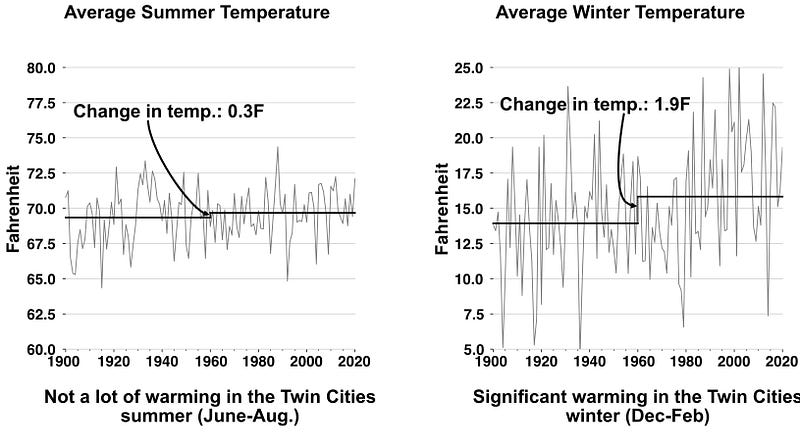Understanding the Paradox of Record Snowfall and Global Warming
Written on
Chapter 1: The Winter Anomaly
December 2020 marked a decade since the notorious "Domebuster" snowstorm, which resulted in the collapse of the Metrodome's roof in Minneapolis, Minnesota, under a staggering 17.1 inches of snow. While it may seem contradictory, Minnesota is witnessing a rise in instances of snowfall exceeding 12 inches, even as winters grow warmer. This phenomenon suggests that rising atmospheric carbon dioxide (CO2) levels are contributing to climate change, manifesting as significant snowfall events. This article aims to clarify the reasons behind the warming climate, particularly in winter, and how this trend enhances the frequency of remarkable snowstorms.
The greenhouse effect plays a crucial role in this warming trend, particularly in winter months.
Section 1.1: The Greenhouse Effect Explained
In winter, a large portion of the land is blanketed in reflective snow, which sends sunlight back into space. This reflected sunlight fails to be absorbed by greenhouse gases like CO2 in the atmosphere. Conversely, when sunlight reaches bare ground, it warms the soil, which then releases heat. This heat is captured by CO2, creating a cycle that continuously warms the atmosphere—a process known as the greenhouse effect.

Fig. 1: Overview of the greenhouse effect, illustrating how snow reflects sunlight, while heat emitted from land contributes to atmospheric warming.
Section 1.2: The Acceleration of Winter Warming
A basic principle of the greenhouse effect states that colder areas warm at a faster rate. The greenhouse effect is intensified by two key factors: the increase of greenhouse gases like CO2 and a decline in snow coverage, which limits the sunlight reflected back into space. Think of the atmosphere as a protective layer for Earth; adding more CO2 is like trading a light jacket for a heavy winter coat. Due to decreased snow cover, winters are now warming quicker than summers, corroborating predictions made by Svante Arrhenius in 1897. This accelerated winter warming, along with other evidence, serves as a clear indicator of the greenhouse effect.

Fig. 2: Comparative analysis of average winter and summer temperatures in Twin Cities, highlighting a notable trend over 60 years.
Chapter 2: The Impact of Warmer Winters on Snowfall
With an understanding of why winters are warming more rapidly, we can explore how this affects extreme snowfall events. Firstly, a warmer atmosphere is capable of holding more moisture, sourced from evaporation off oceans and lakes. This increase in atmospheric moisture leads to greater snowfall. Secondly, heavy snow typically forms when temperatures range between 15–32 degrees Fahrenheit. In this "Goldilocks" zone, ice crystals can combine to form the large, fluffy snowflakes we admire. In contrast, snow forming at lower temperatures resembles fine powder. Therefore, a warm, moist atmosphere during Minnesotan winters creates ideal conditions for significant snow events.
This video, "Why Winter Doesn't Disprove Global Warming," discusses the connection between winter conditions and climate change, offering insights into this often misunderstood relationship.
In the Twin Cities, instances of snowfall exceeding 12 inches have notably increased since 1960, occurring seven times in the last six decades compared to just twice between 1900 and 1960. This data suggests that extreme snow events in the context of global warming may not be as counterintuitive as they seem.

Fig. 3: Seasonal snowfall trends in Twin Cities, with highlighted instances of snowfall exceeding 12 inches.
Reflecting on the legendary "Halloween blizzard" of 1991, when parts of the Twin Cities were blanketed with 28 inches of snow, we can conclude that while we may not experience the same event again, similar occurrences are inevitable. For those who cherish winter activities like sledding at Theodore Wirth Regional Park or snowball fights on campus, rest assured that the warming trends in our atmosphere won't diminish the number of snow days in the future.
The second video, "How Warming is Impacting Snowfall," delves into the relationship between rising temperatures and snowfall patterns, further elucidating the topic.